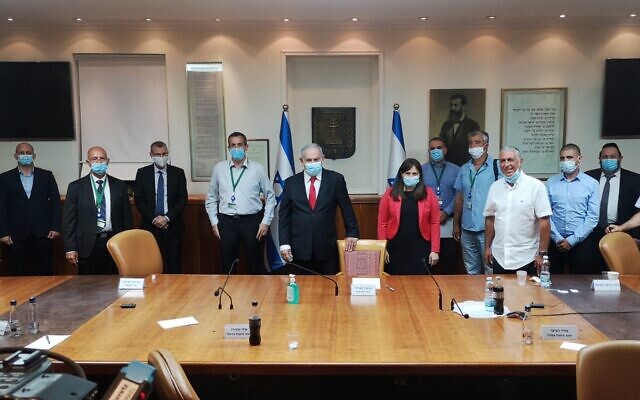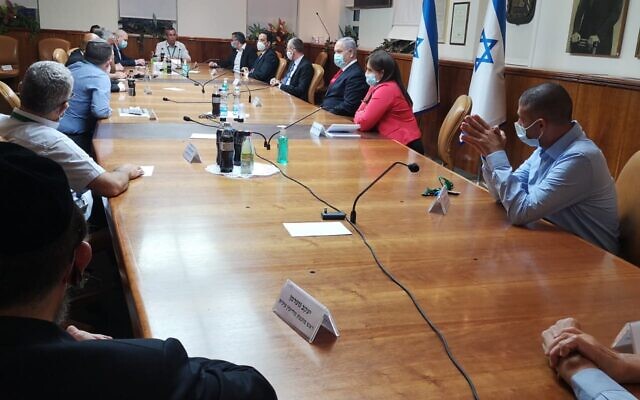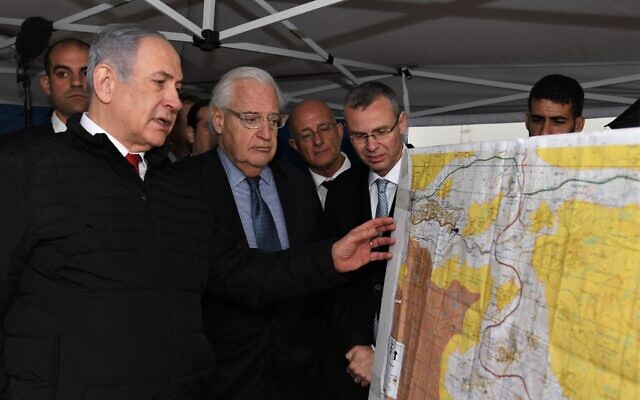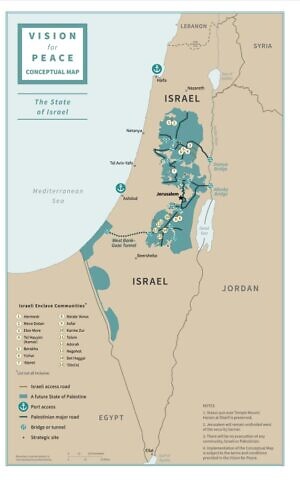Meeting with West Bank mayors who have refrained from trashing Trump plan, PM also quoted saying that the territory conditionally offered to Palestinians doesn’t constitute a state

Prime Minister Benjamin Netanyahu told settler leaders on Sunday that he still intends to annex all West Bank settlements on the July 1 date that is the earliest allowed by his coalition deals, but he acknowledged that annexing other lands allocated to Israel under the Trump peace plan will likely take more time, several participants in the meeting told The Times of Israel.
The remarks reaffirmed Netanyahu’s self-declared July 1 target date for extending Israeli sovereignty to all West Bank settlements but also appeared to mark the first time he has admitted to long-reported delays by the joint US-Israeli team tasked with mapping out the further territories to be annexed, mainly in the Jordan Valley.
Netanyahu’s comments would mean the government would initially annex about three percent of West Bank territory, covering the 132 settlements, home to some 450,000 Israelis. The remainder of the roughly 30% that the Trump deal grants to Israel — most of which is in the Jordan Valley — would be annexed at a later period, when the joint US-Israeli mapping committee finishes determining the exact territorial divisions beyond the pre-1967 Green Line.
The Times of Israel was told last week it was “highly unlikely” that the US would approve an Israeli move to unilaterally annex parts of the West Bank by the July 1 date envisioned by Netanyahu.

Netanyahu also said that while the US may characterize the roughly 70% of non-contiguous West Bank territory being conditionally offered to the Palestinians under the Trump deal as a state, he himself does not do so, according to one official present at the meeting who asked to remain anonymous.
Eleven settler leaders were present at the Sunday evening sit-down with Netanyahu, Knesset Speaker Yariv Levin and Settlements Minister Tzipi Hotovely. Most of the West Bank mayors at the meeting have expressed their support for the Trump plan; all of them have refrained from criticizing the proposal.
They represented a counter to a roughly equal number of their colleagues who have spoken out vehemently against the deal, including one who said it proved that US President Donald Trump is not a friend of Israel and another who threatened to “blow it up” if the PMO and the White House continued to keep settler leaders in the dark regarding the plan’s details.
Netanyahu met with the plan’s settler opponents last week in a meeting that one of the West Bank mayors present described as “far from positive.” The participants said they left feeling that the annexation plans appeared to be slipping away and that the premier had been unable to address their concerns.

The opponents include some of the more senior settler leaders, such as the chairman of the Yesha umbrella council of settler mayors as well as five of the six regional council chairmen in the West Bank.
They claim that the plan leaves all major West Bank highways in the hands of the Palestinians and off limits to settlers, though they have based the assertion on the conceptual map released at the Trump plan’s January unveiling, which the White House says should not be taken literally.
The settler opponents have also warned against the plan’s transformation of 17 settlements into isolated enclaves surrounded by the future Palestinian state, as well as a building freeze in those same communities.
But Netanyahu assured the settler leaders Sunday that “no town or road will be harmed” as a result of the plan, according to Emmanuel Local Council chairman Eliyahu Gafni.
“Highways 60, 90, 55, 5 will all remain under Israeli security control,” Karnei Shomron Local Council chairman Igal Lahav said Netanyahu told them, referring to all the major arteries of the West Bank.
As for the Israeli enclaves envisioned by the plan, Netanyahu assured the settler leaders that they would have roads connecting them to surrounding settlement blocs and that they would still be allowed to develop, with no restrictions on their building, so long as it is within their existing borders, according to Ariel Mayor Eli Shaviro.

Shaviro characterized the meeting as “excellent” and said that all of the mayors left feeling “very supportive” of the plan.

While Netanyahu did not show the settler leaders the maps that are still in progress, he assured them that he was working to annex “as much land as possible within the narrow timeline being granted by the Americans,” according to one participant in the meeting.
Shaviro said that the mayors made a point of telling Netanyahu that they see Trump as a “true friend of Israel” and appreciate all that he has done for the Jewish state. They asked that the message be passed along to the White House, which has called the settler opponents “ungrateful,” according to several mayors who spoke last week to The Times of Israel.
Lahav said Netanyahu agreed to be more receptive to the frustrations of settler leaders mayors who feel they have been kept in the dark regarding the mapping of land surrounding their communities. The premier also agreed to keep the mayors in the loop as more progress is made by the joint US-Israeli committee, the Karnei Shomron mayor said.
Later Sunday evening, Netanyahu was set to meet with Defense Minister Benny Gantz and Foreign Minister Gabi Ashkeanazi in what would be the first such three-way meeting to discuss annexation.
The new dose of optimism expressed by settler leaders at the meeting came less than a week after a well-placed source told The Times of Israel that the US administration is highly unlikely to approve an Israeli move to unilaterally annex parts of the West Bank by the July 1 date envisioned by Netanyahu.
Asked to comment on such speculation, Shaviro said that while he is “not religious, he prays that Trump will give the green light” on annexation by July 1.
As reported by The Times of Israel
